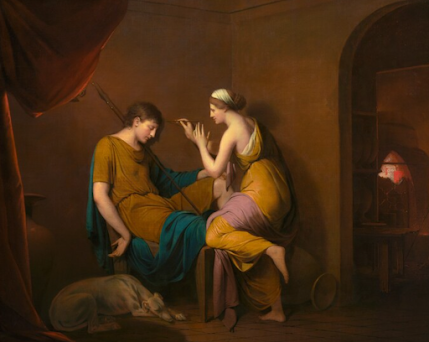Renaissance Art Analysis
Boccaccio, Dante, Petrarca
By: Giorgio Vasari
"The 1544 CE painting by Giorgio Vasari (1511-1574 CE) known as the 'Portrait of Six Tuscan Poets'. The poets are (left to right): Cino da Pistoia, Giuttone d'Arezzo, Petrarch, Giovanni Boccaccio, Dante Alighieri and Guido Cavalcanti." (Art). This piece really stands out to me because all the contrast of the different colors of clothing and items in the painting is so rich for the eyes to view. The different pinks of the gown on the man holding the book, the green of the tablecloth, the red of the head and neck pieces on some of subjects in the painting and the dark background really highlights these colors. I also really enjoy how the different textures are painted so realistic and delicate looking, I can imagine what the linen of the clothes feels like or how the leafy crowns on their heads would be smooth and cooling to the touch, when a painting has elements like this where I can imagine how my senses would perceive them, I always look at them and let my imagination run through my mind. When I view this piece, I feel the emotions of satisfaction and gleefulness, the people in the painting all look like they are having productive and knowledgeable conversation and it is satisfying to know that all the artists depicted had similar styles of art and could socialize together and discuss their art together. I would love to have this art in my own home, and it would be a good conversation starter to discuss what I and someone else admire in the painting and who is featured in the piece. As stated in this source "He built his own home in Arezzo, which is now a museum in his honor, and the walls are decorated with his beautiful paintings. Vasari was elected to the Arezzo council, and later earned the supreme title of gonfalonier, a prestigious office at that time. Giorgio Vasari died in Florence, Italy, in 1574 as a respected artist, architect, and famous historian." (Brandon) I believe this piece was painted in Florence, Italy or Arezzo, Italy.
This piece is also a great example of the humanism style of artwork. Humanism to me means artists during this time period were taking inspiration from Greek art in the past and painting, sculpting, drawing, etc. humans, being human. Reality was deemed just as beautiful and worthy of recording and depiction just as much as gods or heroes/heroines of stories were. So, a lot of art pieces came about of people doing daily ordinary things within the amazing cities or in nature. Full human bodies were being included in art pieces instead of portraits or just from the waist up. People in chapels, walking down the street, enjoying a local market, or in this case artists in a room having discussions amongst themselves and doing some reading and enjoying some food. As stated in this website "Italian Renaissance painting, especially in its secular forms, is alive with visually coded expressions of humanistic philosophy. Symbol, structure, posture, and even colour were used to convey silent messages about humanity and nature."(Britannica). Compared to some past art styles the humans in this time period did not have extenuated features or were made to look like royalty or what artists imagined when hearing a tale of a hero, it was like this painting of people enjoying each other's company and the artist admiring that and bringing the scene to life through paint.
Works Cited:
“Humanism.” Encyclopædia Britannica, Encyclopædia Britannica, Inc., https://www.britannica.com/topic/humanism.
Brandon. “Giorgio Vasari Biography (1511-1574) - Life of an Italian Artist.” Totally History, 20 Sept. 2012, https://totallyhistory.com/giorgio-vasari/.
Art, Minneapolis Institute of. "Six Tuscan Poets by Vasari." World History Encyclopedia. World History Encyclopedia, 21 Oct 2020. Web. 05 Oct 2022.




Hi, thank you for sharing this piece! I agree with you on the colors being super appealing. The colors are vibrant, but they are also expertly combined to create shadows and depth. The artwork exhibits humanism very well. You can see that each individual in the painting has humanistic flaws and features. They are also conversing and generally interacting with average objects on the table. The contrasting colors in the background to the people show a lot of depth and 3-dimensional features.
ReplyDelete